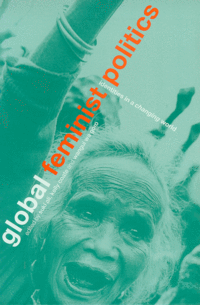

![]()
![]()

An important sub-theme of the book concerns 'race'/ethnicity and nationalism/nationalist movements. For instance, Unterhalter reviews a substantial number of testimonies of South African women in exile up until 1995. She found that gendered meanings and obligations continued in exile, rather than exile constituting a radical 'break' with existing gender relations. South African women of differing backgrounds continued to feel obliged to family and to 'home'. Further, women were more likely than male exiles not to have fulfilled expectations concerning education, employment and income while abroad, and to envisage themselves as 'failures'.
Fenster, in a study of Bedouin women in the Negev, Israel, discusses changing cultural perceptions of spaces which are 'permitted' and 'forbidden' to them. She does this in the framework of a critique of the modernist/authoritarian planning project which seeks to regulate the lives of the Bedouin within Israel. However, cultural (and male-enforced) ideas of female modesty operate along with the planning project to further constrain Bedouin women's lives.
Lentin, drawing on themes discussed elsewhere in her research, discusses how catastrophes, including genocides, are both gendered and feminised: feminised both in the sense of using images of women as emblematic, and 'feminised' in order to belittle events. Ugris' paper revisits the notion of (ethnic, gendered…) `community' as applied in the rhetoric of urban planning. Suki Ali's chapter is an insightful study of the complexities of 'mixed-race' identities among children in north London. The collection might have gained in coherence if 'race'/ethnicity (and associated cateogories) had been more explicitly highlighted as themes.
Turning to the contributions which consider women's, feminist and other social movements: Thapar-Bjorkert discusses the issue of 'participation', using the example of Brahmin women in the Indian nationalist movement. She emphasises the shortcomings of viewing 'movement' as only taking place in the street (i.e. on demonstrations, strikes, etc.) and examines women's participation in less overt activities: conducting secret activities; supporting friends and relatives in their activities; spinning khadi (the coarse hand-spun cloth which became a nationalist/Ghandian statement); and keeping fasts. Women, including those in seclusion, sometimes acted independently of or in opposition to husbands, fathers and fathers-in-law. Thapar-Bjorkert's contribution is a valuable one, but given the volume of literature now published on gender and nationalism, the tensions between gender and nationalist interests might have been explored more. Fester's paper on women's organisations formed in the last stages of apartheid in the Western Cape provides an informative overview of the subject. Within these organisations, the emphasis was (as in the case of the Indian nationalist movement) on national liberation, on supporting menfolk; and on women's roles and resistance as mothers. Multiple feminist strategies were evident in dealing with the situation of crisis and intensified state oppression emerging in the last days of apartheid. Alliances across racialised groupings were formed, as well as along class lines. Fester begins to analyse the tensions in such alliances; and further exploration of such tensions and attempts to overcome them would have been welcome in other contributions.
Two short chapters in the Global Feminist Politics deal more generally with the current state of women's and feminist movements. Nighat Khan's polemical article writes of the Pakistani women's movement. She criticises feminists, especially urban-based groups (often seen as encompassing all feminism), for their professionalisation and loss of core values: consciousness-raising, anti-hierarchical principles, and an emphasis on the personal as political. All of this, she argues, implies an acceptance of male norms of behaviour and organisation. Further, this is integrally bound up with dependence on NGO funding, with the bureaucratisation and external orientation entailed.
Epstein and Steinberg discuss the lack of 'fixed abode' for 1990s UK feminism. This chapter also takes up the theme of decline in feminist activism, along with decline of other left activism. Universities have come to be important locations for feminist writing and thought, including through formal courses in Women's Studies, Gender Studies and associated fields. However, feminists still tend to be marginal within the academy. Perhaps paradoxically, while activism declines, some tenets of feminism, for example, opposition to homophobia, or violence against women/other marginalised groups, have achieved a certain measure of acceptance within British popular culture. Feminism in the 1990s and into the 21st century is at once multi-centred and in need of "an address".
(In a related vein) Jane Kenway and Diana Langmead end the book with a discussion of globalization, the place of the (Australian) university within changing social and economic structures and a review of feminist work touching on these wide themes. The chapter implies that feminists have not engaged sufficiently with the changing place of intellectuals and of universities, especially given that the latter often provide (contradictory) 'spaces' for feminist thought. Within universities, feminists must continue to provide a focus for non-dominant perspectives.
Thus a number of chapters constitute insightful contributions to gender studies. However, the book would benefit from a clearer focus. Ali's introduction and Coate's conclusion are helpful, but both are short: more extended pieces might have helped to draw together different strands evident in this collection.
Susie Jacobs
Manchester Metropolitan University